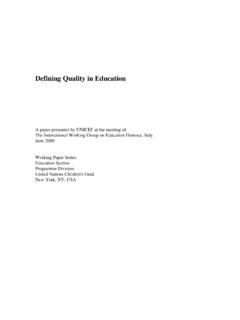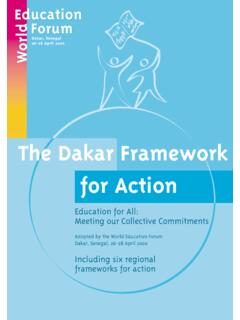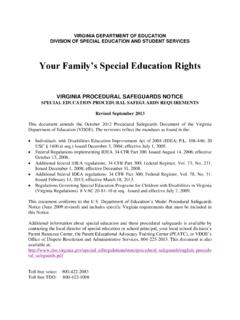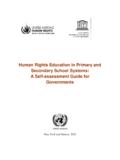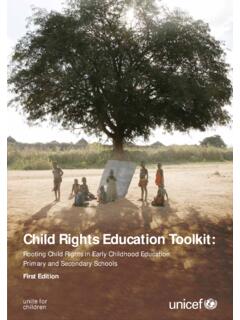Transcription of A Human Rights-Based Approach to EDUCATION FOR ALL
1 A Human Rights-Based Approach to EDUCATION FOR ALLA Human Rights-Based Approach to EDUCATION United Nations Children s Fund/United Nations Educational, Scientifi c and Cultural Organization, 2007 United Nations Children s Fund3 United Nations PlazaNew York, NY 10017, Nations Educational, Scientifi c and Cultural Organization7, place de Fontenoy75352 Paris 07 SP, photo: A girl reads outdoors at her school in Kingston, Jamaica UNICEF/HQ05-0916/Shehzad NooraniSales number: : 978-92-806-4188-2 Price: $ to reproduce any part of this publication is will be freely granted to educational or non-profi t organizations. Others will be requested to pay a small contact the Editorial, Design and Publications Section,Division of Communication, UNICEF New York (address above)Tel: 212-326-7434 Fax: 212-303-7985 Email: Human Rights-Based Approach to EDUCATION FOR ALLA framework for the realization of children s right to EDUCATION and rights within EDUCATION Contents iii CONTENTSP reface and acknowledgements.
2 ViiForeword .. xiAcronyms .. xiiiMy right to learn.. xivIntroduction.. 1 Chapter 1: Human rights and EDUCATION .. 7 EDUCATION as a Human right .. 7 Human Rights-Based approaches to development .. 9 The principles that inform a Rights-Based Approach .. 10 Adopting a Rights-Based Approach to EDUCATION ..11 Applying a Rights-Based Approach to policy and programming .. 13 Situation assessment and analysis .. 16 Assessing capacity for implementation .. 17 Programme planning, design and implementation .. 18 Monitoring and evaluation.. 19 Addressing tensions in fulfi lling the right to EDUCATION .. 20 Reconciling confl icting agendas for EDUCATION .. 20 Balancing rights and responsibilities of children.
3 22 Tensions in the implementation of a Rights-Based Approach .. 22 Chapter 2: A Rights-Based conceptual framework for EDUCATION .. 27 Introduction .. 271. The right of access to EDUCATION .. 29 EDUCATION throughout all stages of childhood and beyond .. 30 Availability and accessibility of EDUCATION .. 31 Equality of opportunity .. 312. The right to quality EDUCATION .. 32A broad, relevant and inclusive curriculum .. 33 Rights-Based learning and assessment .. 33A child-friendly, safe and healthy environment .. 34iv A Human Rights-Based Approach TO EDUCATION FOR ALL3. The right to respect in the learning environment .. 35 Respect for identity.
4 35 Respect for participation rights .. 36 Respect for integrity .. 37 Chapter 3: State obligations and government responsibilities.. 39 Creating a supportive political and economic environment .. 40 Progressive realization of EDUCATION rights .. 40A conducive political environment .. 41 Rights-Based analysis and planning .. 43 Disaggregated data collection, monitoring and evaluation .. 46 Meaningful intersectoral collaboration .. 48 Effective partnerships .. 50 Establishing a robust legislative framework .. 52 EDUCATION as a right for all children.. 52 Elimination of discrimination.. 53 Minimum standards .. 53 Best interests of the child.
5 54An inclusive framework .. 54 Elimination of child labour .. 54 Birth registration .. 55 Participation rights .. 55 Prohibition of all forms of violence against children .. 56 Developing Rights-Based EDUCATION policies .. 56 Policies to ensure access to EDUCATION .. 56 Policies to provide quality EDUCATION .. 66 Policies to promote respect for Human rights in schools .. 75 Policies to ensure children s participation.. 79 Chapter 4: The role of other duty bearers.. 87 Parents and other caregivers .. 88 Parental responsibilities .. 88 Provision of EDUCATION for parents .. 89 Contents v Parents as partners .. 90 Communities .. 90 Promoting local awareness.
6 91 Analysing local barriers .. 92 Providing accurate information on the preschool and school-agedpopulation .. 92 Supporting schools .. 93 Teachers .. 93 Head teachers .. 93 Duties of teachers .. 95 Civil society organizations .. 97 Collaborating in the provision of EDUCATION .. 97 Mobilizing and capacity-building.. 98 The international community .. 99 Strategies for promoting Rights-Based EDUCATION .. 99 Issues to address in promoting Rights-Based EDUCATION .. 100 Bibliography .. 102 Normative and standard-setting instruments .. 109 Conventions .. 109 Declarations, programmes and plans of action ..110 Web resources and initiatives .. 111 Appendix I: The Human Rights-Based Approach to development cooperation.
7 113 Appendix II: The Convention on the rights of the Child and EDUCATION ..118 Appendix III: Overview of global goals pertaining to EDUCATION .. 120 Appendix IV: A checklist for action: State obligations in ensuringthe right to EDUCATION .. 122 Appendix V: World Programme for Human rights EDUCATION , Plan of Action 2005 2007 .. 128 Appendix VI: Practice standards in children s participation .. 131 Endnotes .. 140 PREFACE AND ACKNOWLEDGEMENTSThis document brings together the current thinking and practice on Human Rights-Based approaches in the EDUCATION sector. It presents key issues and challenges in Rights-Based approaches and provides a framework for policy and programme development from the level of the school up to the national and international levels.
8 Rights-Based approaches have only recently become a focus within the EDUCATION sector. This document was thus developed as a resource for government offi cials, civil society organizations, United Nations and bilateral agencies, and other development partners strategically involved in the development of EDUCATION policies and programmes. It is intended to guide the dialogue of the United Nations Development Group and EDUCATION for All (EFA) partnerships and facilitate a breakthrough from the rhetoric of the right to EDUCATION to concrete and accelerated interventions at policy and programme levels for attaining the EFA goals and the Millennium Development Goals related to document is positioned within and builds on the UN Statement of Common Understanding on a Human Rights-Based Approach to Development Cooperation.
9 In this regard we hope it will be shared and used within the context of UN Reform and donor harmonization. More particularly, we hope it will be adopted by the UN EDUCATION Theme Group at the country level in developing the EDUCATION component of a Common Country Assessment/UN Development Assistance Framework and to guide a common UN stance in larger country-level forums, such as EDUCATION sector-wide approaches, the Multi-Donor Budget Support Group, the EFA Fast Track Initiative, the EFA Group, the Consultative Group and the predominant focus of the document is on primary basic EDUCATION and child rights within EDUCATION , it is based on the EFA goals and situated within life-cycle and lifelong learning approaches.
10 It addresses the right to EDUCATION as well as rights within EDUCATION , which include Human rights EDUCATION itself. The document therefore needs also to be seen in the context of the World Programme for Human rights EDUCATION , which was adopted through a UN General Assembly resolution in 2004, and which is being implemented through a Plan of Action, prepared by the Offi ce of the United Nations High Commissioner for Human rights (OHCHR) and the United Nations Educational, Scientifi c and Cultural Organization (UNESCO), with a focus on primary and secondary school systems in its fi rst and acknowledgements vii viii A Human Rights-Based Approach TO EDUCATION FOR ALLThe project of preparing this document was initially started by the United Nations Children s Fund (UNICEF) (as a collaborative initiative between its EDUCATION Section and Human rights Unit) and evolved as a joint effort with UNESCO.
